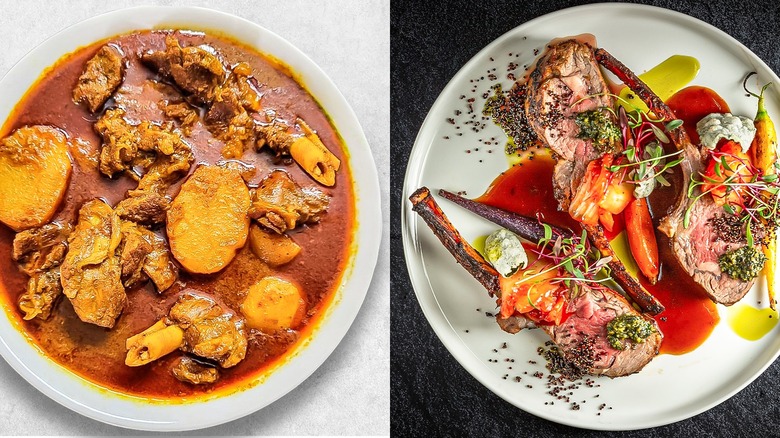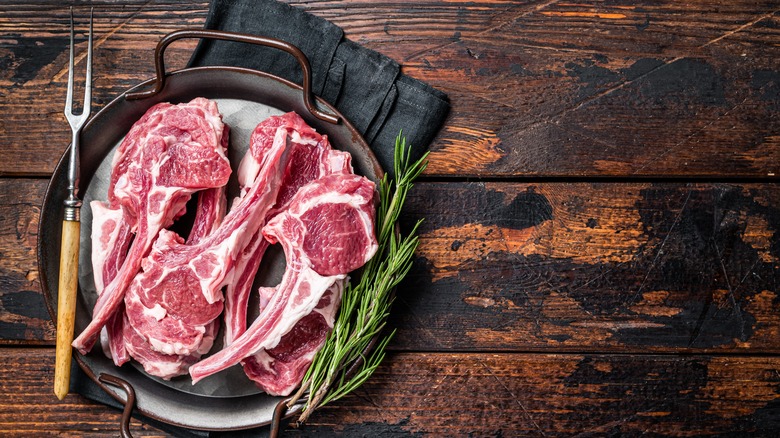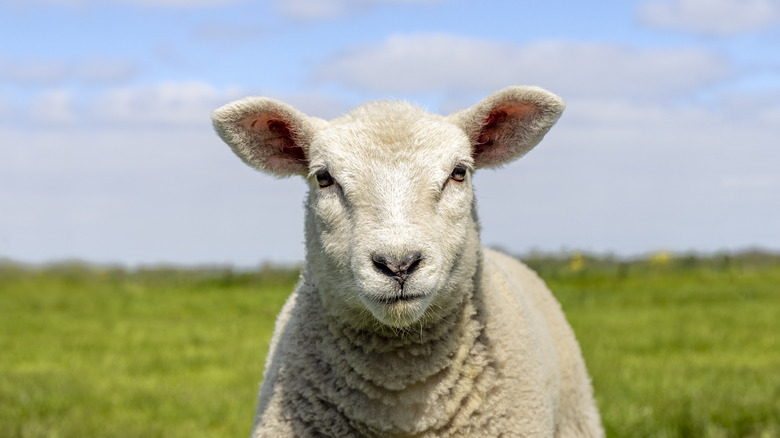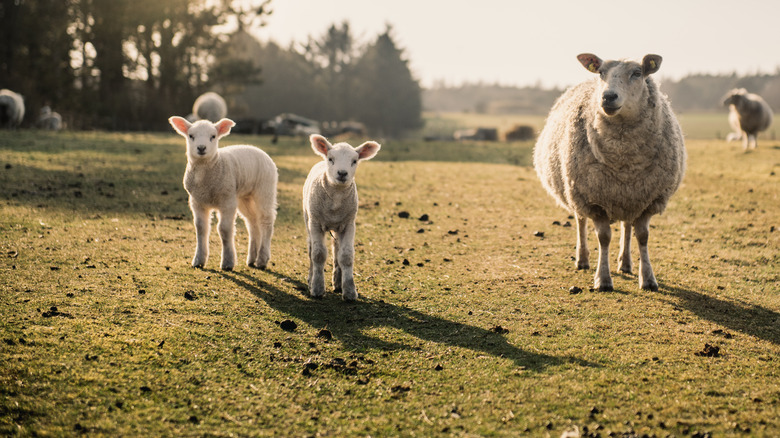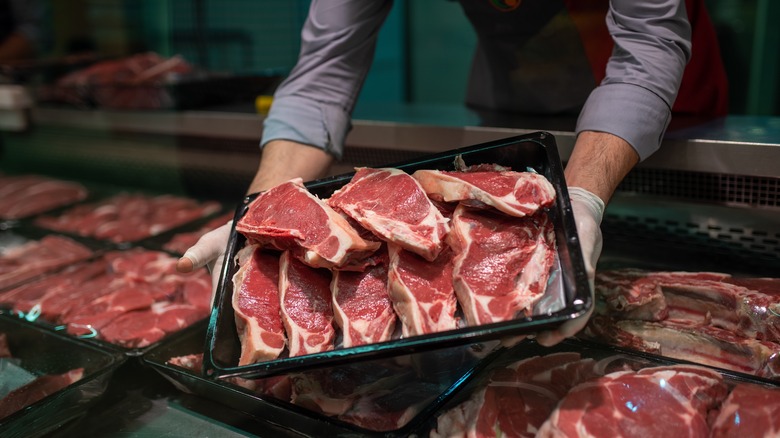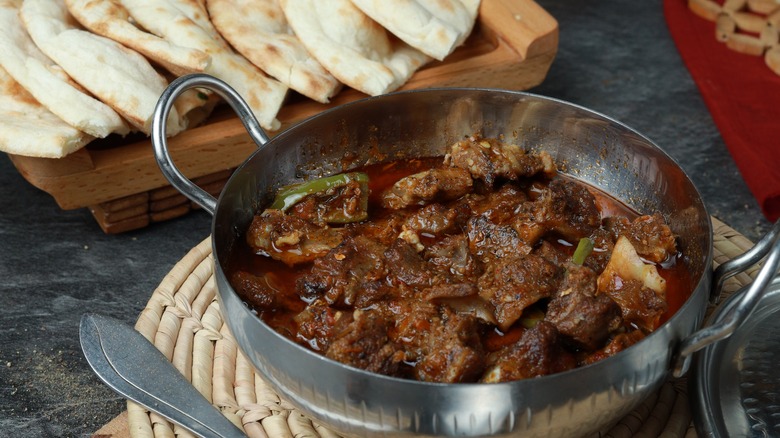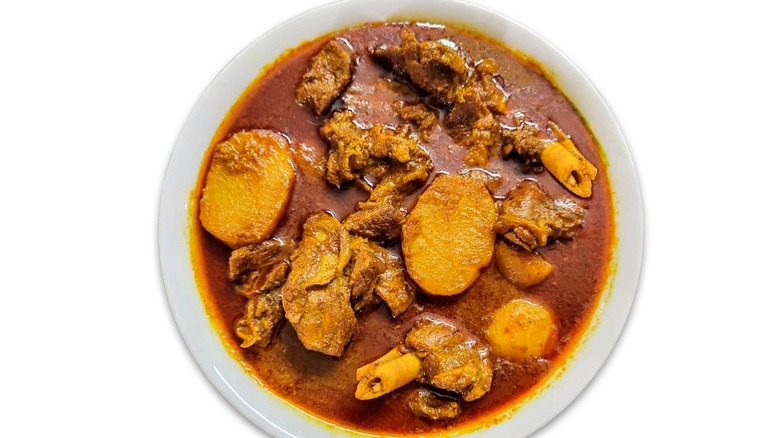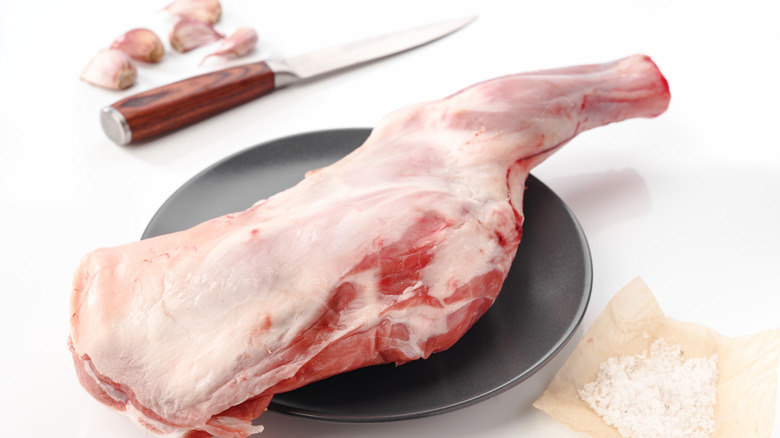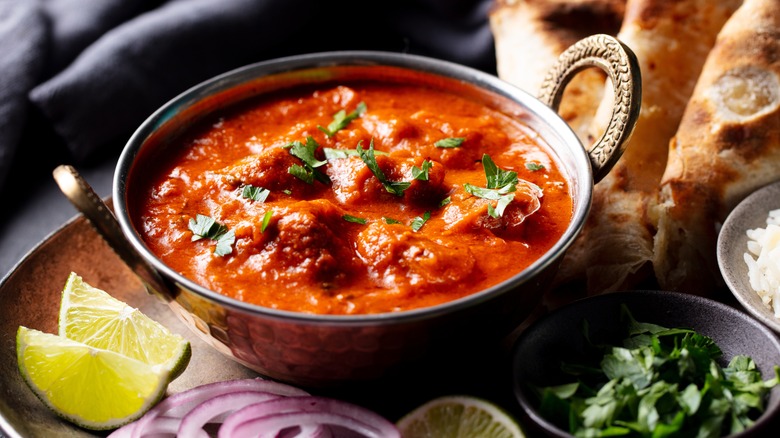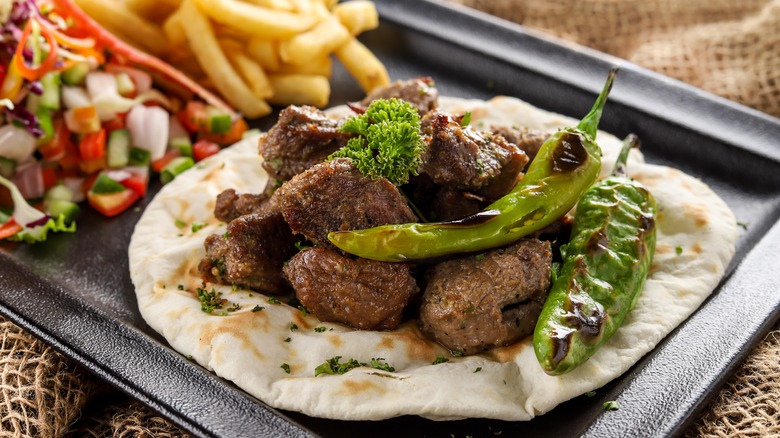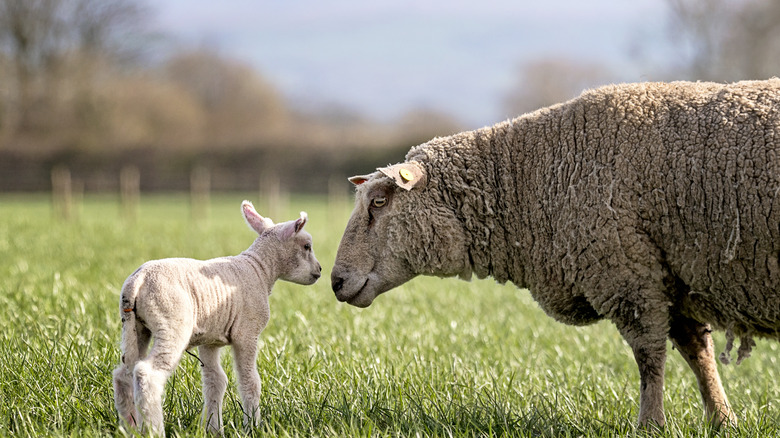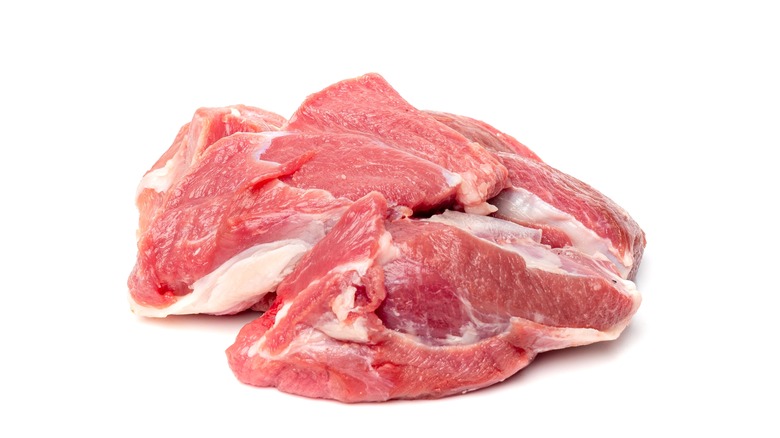What Is Mutton, And Why Is It Different From Lamb?
Although chicken, beef, and pork are mainstays in American cuisine, other types of meat, like sheep, are less prevalent. For most of us, lamb chops, lamb stew, and an Easter lamb roast usually come to mind when we think of sheep. Because many families opt for preparing pre-cooked Easter ham instead of lamb, it's become even less common. If lamb is a rare delicacy for you, mutton is likely even rarer. Although mutton is still a staple meat in some parts of the world, it's not very popular in the U.S. You may even be unsure precisely what mutton is.
Often, mutton meat is mistaken for lamb and may even be improperly labeled as lamb meat by some butchers and grocers. While both types of meat come from sheep, though, there is one core difference, and that's the age of the animal. Mutton is processed when the sheep is older, which results in an entirely different texture, flavor, and cost. By researching and consulting expert Chef Peyton White, we've gathered all the facts you need to know when considering purchasing and cooking mutton or lamb. From start to finish, here is how to work with this meat that is as tasty as it is considered exotic in the U.S.
What is mutton?
Mutton is not the most popular type of meat in the U.S. today, but for foodies, it still has its place. If you've never had mutton, you may wonder exactly what it is — mutton is a type of sheep meat. The term doesn't refer to a specific cut or type of meat; it actually refers to the maturity of the sheep. Mutton meat comes from a mature lamb between the ages of 1 and 3. A sheep slaughtered at a year old is referred to as a yearling mutton, while an older one is just called mutton. Typically, mutton comes from a 2-3-year-old sheep when the animal is no longer used for milk or wool.
Mutton meat can be divided and sold in various ways, including mutton chops, steaks, ribs, legs, or ground mutton, so there are a variety of ways you can eat it. Because of the animal's age, mutton has a strong flavor profile but is not very tender. The taste is often described as gamey. While some eaters love that bold flavor, for others it is a bit too strong.
Note that while mutton typically refers to mature sheep meat in the West, the same term is used for goat meat in South Asian or Caribean cuisine. In Indian cuisine, mutton refers to both sheep and goat meat.
What is the history of mutton?
Although mutton isn't as popular today, for centuries, sxheep meat was relied on by people around the world. Raising sheep began about 9,000 years ago in the Middle East and has since been an essential food source in many cultures throughout history. In "Book of Household Management" by Isabella Beeton, she wrote about sheep, "Of all wild or domesticated animals, without exception, the most useful to man as food."
Mutton also became a staple dish enjoyed in households throughout the United Kingdom. However, its production in Britain declined during World War II when many of the farmers were enlisted. According to Pipers Farm, the war changed the culinary landscape, and mutton never fully regained its title as a mainstay dish in British culture. As New Zealand became prominent for sheep production, local British farmers also had less incentive to continue raising mutton. Over the years, sheep meat has become less common, and even when selecting sheep meat, many consumers opt for lamb instead of mutton.
What is the difference between lamb and mutton?
Both lamb and mutton are types of sheep meat; the distinction between the two is when the animal is slaughtered. Lamb meat comes from young lambs under a year old, while mutton is typically between two and three years old. Peyton White, the executive chef at The Select in Charleston, South Carolina, explained the difference to Chowhound. "It's just all based on [the] age difference of a lamb," White said. "Mutton acts more like a Chuck cut that needs to be braised [or] slow-cooked. Lamb is usually more tender and lean." He added that mutton meat has more fat due to the sheep's age.
If you want to get more specific when shopping, you can further categorize sheep meat based on its age. Baby lamb refers to meat harvested when the sheep is between 6 and 10 weeks. Spring lamb is harvested between 5 to 6 months old. A 12- to 24-month-old sheep is considered a yearling mutton, and older than that is categorized simply as mutton meat.
Is mutton or lamb more expensive?
When it comes to sheep meat, lamb is much more desirable and sought after in the U.S. than mutton. The more delicate texture and flavor make lamb more palatable than gamey mutton. Many families also enjoy lamb as part of their traditional Easter dinner; the perfect roasted leg of lamb makes an excellent celebratory meal. Because of these reasons, lamb is more expensive and more readily available in America than more aged mutton meat. However, if you're in the market for sheep meat and have the choice between the two, you will get more for your money by purchasing mutton. Because lamb is slaughtered younger, it's smaller than mutton and has less meat. The older sheep produce more meat, so you'll get more food for cheaper.
However, if you're new to cooking sheep meat, Chef Peyton White said home cooks are better off preparing lamb over mutton. "Lamb is by far the easier protein to cook with at home," he explained. "The flavor is so much easier to pair with things you can acquire at local markets." Although making tender and rich mutton is definitely possible, it is more work and more time-consuming. While lamb is more expensive, for many cooks, it's worth it to purchase a more naturally tender cut of meat without the tough texture and gamey flavor that sometimes comes with mutton.
What does mutton taste like?
If you're looking for flavor, mutton contains more fat and a stronger taste than delicate lamb meat. "Mutton has more flavor since it is aged longer. It is like using a short rib instead of a filet mignon — you can put more flavor into it when cooking," Chef Peyton White explained. Lamb, on the other hand, is the more mild and tender option. This might make you wonder why the more flavorful meat isn't the more popular choice. It's because mutton's bolder taste is not to everyone's liking.
The older meat is often described as gamey, meaning it tastes and smells more strongly than most the storebought meats we are used to enjoying today. It's pungent and slightly earthy. "What it all comes down to is a particular type of fatty acid that lambs have and beef and chicken don't. It's called branched-chain fatty acid," Lael Gilbert explained to Utah Public Radio. "Animals that are grass (rather than grain) fed, or that eat a wild diet will come across as more gamey," Gilbert continued. While this can be very enjoyable, it is more of an acquired taste that has become less common in grocery stores and on restaurant menus. When prepared properly, however, it can be a wonderful umami experience.
Where is mutton popular?
Mutton is not very common in the United States. While it can be found in some local butchers and specialty markets, it hasn't taken off in the same way beef, chicken, and other meats have. Historian Roger Horowitz explained this phenomenon to Modern Farmer, saying, "The simplest story is that no commercial meat industry developed around mutton. It seems to me that it was very rural in character." Chef Peyton White added to this, "Sheep meat in America was actually discouraged for the early parts of America's development due to lobbying in the Wool marketplace. It never quite picked up after that." Because of this, mutton is uncommon and can be difficult to source in the U.S.
However, that does not mean that sheep is obsolete. In fact, in many parts of the world, it is still a widely used staple protein. According to Chef White, sheep meat is heavily manufactured in New Zealand and Australia. It's also enjoyed in Africa, Central America, and especially the Middle East. Donald Aspinwall Allan wrote in an article that families often raise their own sheep in Lebanon. "Towards the end of Ramadan, the [Muslim] feast live sheep may even be seen on the balconies of Beirut apartments," Allan wrote. Because of mutton's unique taste, it works best in cuisines with many added spices and flavors. Mutton is used in stews, curries, sausages, and other flavorful meat dishes worldwide.
Where to buy mutton
If you're intrigued by the flavor of mutton and excited to try it in your cooking, you may hit a roadblock buying the meat. Because there's not a large market for mutton in the United States, it can be challenging to get your hands on. When you visit a standard grocery store in the U.S., you have plentiful cuts of chicken, beef, pork, and turkey to choose from, but pickings are slim for sheep. While you can often find lamb chops and other varieties of lamb meat, mutton is not typically sold as there is not a large market for it with Americans, but this does not mean you can't get it; you'll just have to go through different sources.
On your hunt for mutton, Chef Peyton White recommended skipping over big grocers and instead starting at your local butcher's shop. Megan Wortman, executive director of the American Lamb Board, agreed with White, telling Modern Farmer, "Mutton is not an accessible protein option in the U.S. ... You'd have to go through a specialty butcher shop or directly to a special-order processor." If your local butcher doesn't carry mature sheep meat, you can order it online from vendors like Heritage Foods, Mutton Butcher Shop, and Glynwood Center for Regional Food and Farming. Because mutton is more prevalent in Middle Eastern cuisine, you'll often have better luck shopping at a local Halal market or Halal butcher. Halal World Depot is another good source of sheep and goat meat.
How to cook with mutton
Although mutton sometimes has a bad reputation due to its intense flavor, when appropriately prepared, it can be made into many delicious dinner recipes. Because the sheep are older when processed, mutton meat is tough compared to naturally tender and delicate lamb meat. Just like beef chuck and other tougher meat varieties, though, it can become tender when simmered slowly. Chef Peyton White said that when he thinks of mutton, the first recipe to come to mind is making a rich stew. As the meat slowly stews, it becomes more tender and absorbs flavor from the cooking liquid around it. This serves the dual purpose of tenderizing the meat and using aromatic herbs and spices in the stew mixture to neutralize the gamier flavor.
When it comes to cooking mutton vs. lamb, slow cooking methods are the best option for mutton. This includes stewing, braising, and slow cooking. Mutton is an excellent meat for stews, soups, curries, and other saucy and flavorful dishes. Mutton curry tastes particularly delicious served over perfectly cooked rice. You can also replace lamb or beef in some of your favorite recipes, using mutton instead. For example, you can use mutton the next time you make 30-minute lamb stew for a more flavorful protein option.
Is mutton healthy?
Now we know that mutton can be a flavorful and affordable meat option, but before adding it to your diet, you may be curious if it's a healthy meat option. It's first important to establish that sheep meat is considered red meat, just like beef, veal, and pork (though ham is sometimes considered a third category apart from red and white meat). Red meats are higher in saturated fats, which can increase your risk of heart disease. "There is evidence that shows that too much red meat is not good for your health," registered dietician Julia Zumpano told the Cleveland Clinic. "But the quality, quantity and frequency of the red meat you eat all play a big role on the health risks."
The good news is that mutton has lower levels of saturated fat than most types of red meat. It's also an excellent source of protein and has high levels of iron, so it can be a healthy meat option, particularly when eaten in moderation. Like with any ingredient, how healthy your mutton recipe is depends heavily on how you prepare it. If you're adding a lot of fat, sugar, or sodium while flavoring and cooking the meat, this will alter the overall nutritional value of the dish.
Best sources of lamb and mutton
Over time, the sheep industry has declined in the U.S. in terms of both meat and wool production. According to the U.S. Department of Agriculture's Economic Research Service, America's sheep industry began in 1867 and peaked in 1884 with 51 million sheep. However, since then, the market has dropped off drastically. In 2016, it was counted at five million, less than a tenth of what it was at its height. Along with the decrease in the amount of livestock, the number of farming operations raising sheep in the U.S. has also declined. Due to this, consumers are better off purchasing sheep imported from foreign industries like Australia and New Zealand, which are known for sheep production.
Chef Peyton White recommended looking to New Zealand when purchasing mutton meat because the grass-fed sheep have the strong, gamey flavor to be expected from sheep meat. However, if you're looking for mild lamb meat, he added that you may have more luck in local markets. "Lamb has become more popular in the last decade due to America introducing a milder flavor version to the lamb market," White said. "New Zealand and Australia provide a gamier version of the protein that most Americans find a little too much for their palate."
How to store mutton
Just like any food, proper storage and preparation protects sheep meat from attracting harmful bacteria. When purchasing raw sheep meat, keep it covered and get home to chill as quickly as possible. You can keep the meat in its original packaging for storage. If you notice any leakage, place the package in a ziplock bag or another airtight container, and then put the uncooked meat in the fridge. Ground sheep or stew meat can be stored safely in the refrigerator for one to two days, while whole cuts like chops, steaks, and ribs will stay good longer and can be kept for three to five days. If you're planning to freeze the raw meat, wrap it carefully in plastic wrap or place it in a freezer bag. Use frozen ground sheep for three to four months and whole cuts of meat for six to nine months. The same safety guidelines apply to lamb and mutton.
For safe preparation, cook the sheep to an internal temperature of 165 F. Cooked meat can be stored in an airtight container in the fridge for three to four days or in the freezer for up to three months. Remember to keep your refrigerator at the right temperature so that food stays chilled and flavorful during storage.
Cooking and storage temperatures are key knowledge for handling all kinds of meat. Following the temperature guide can help you make the perfect steak and transform your dinner experience.
